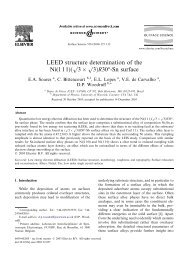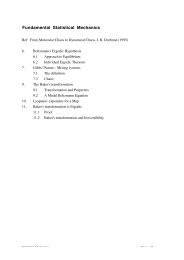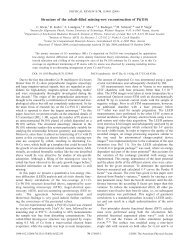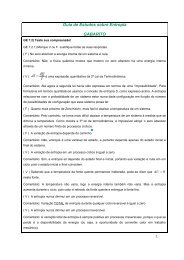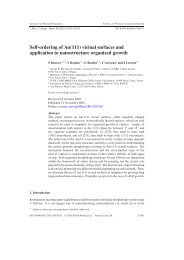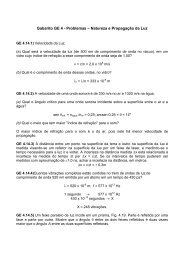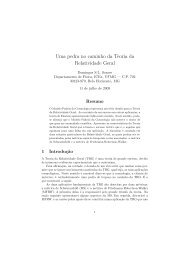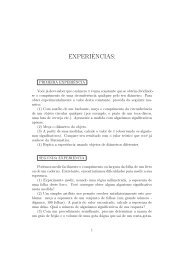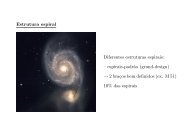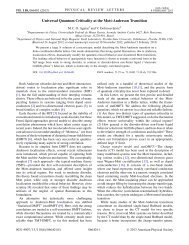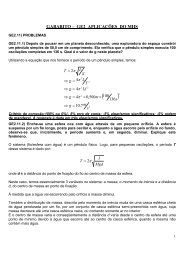Quantitative Assessment of the Interplay Between DNA Elasticity ...
Quantitative Assessment of the Interplay Between DNA Elasticity ...
Quantitative Assessment of the Interplay Between DNA Elasticity ...
Create successful ePaper yourself
Turn your PDF publications into a flip-book with our unique Google optimized e-Paper software.
PRL 109, 248103 (2012) PHYSICAL REVIEW LETTERS<br />
<strong>Quantitative</strong> <strong>Assessment</strong> <strong>of</strong> <strong>the</strong> <strong>Interplay</strong> <strong>Between</strong> <strong>DNA</strong> <strong>Elasticity</strong> and Cooperative<br />
Binding <strong>of</strong> Ligands<br />
L. Siman, 1 I. S. S. Carrasco, 2 J. K. L. da Silva, 1 M. C. de Oliveira, 3 M. S. Rocha, 2 and O. N. Mesquita 1<br />
1<br />
Departamento de Física, ICEx, Universidade Federal de Minas Gerais, Caixa Postal 702, CEP 31270-901 Belo Horizonte,<br />
Minas Gerais, Brazil<br />
2<br />
Departamento de Física, Universidade Federal de Viçosa, CEP 36570-000 Viçosa, Minas Gerais, Brazil<br />
3<br />
Escola de Farmácia, Universidade Federal de Minas Gerais, CEP 31270-901 Belo Horizonte, Minas Gerais, Brazil<br />
(Received 19 January 2012; published 10 December 2012)<br />
Binding <strong>of</strong> ligands to <strong>DNA</strong> can be studied by measuring <strong>the</strong> change <strong>of</strong> <strong>the</strong> persistence length <strong>of</strong> <strong>the</strong><br />
complex formed, in single-molecule assays. We propose a methodology for persistence length data<br />
analysis based on a quenched disorder statistical model and describing <strong>the</strong> binding iso<strong>the</strong>rm by a Hill-type<br />
equation. We obtain an expression for <strong>the</strong> effective persistence length as a function <strong>of</strong> <strong>the</strong> total ligand<br />
concentration, which we apply to our data <strong>of</strong> <strong>the</strong> <strong>DNA</strong>-cationic -cyclodextrin and to <strong>the</strong> <strong>DNA</strong>-HU<br />
protein data available in <strong>the</strong> literature, determining <strong>the</strong> values <strong>of</strong> <strong>the</strong> local persistence lengths, <strong>the</strong><br />
dissociation constant, and <strong>the</strong> degree <strong>of</strong> cooperativity for each set <strong>of</strong> data. In both cases <strong>the</strong> persistence<br />
length behaves nonmonotonically as a function <strong>of</strong> ligand concentration and based on <strong>the</strong> results obtained<br />
we discuss some physical aspects <strong>of</strong> <strong>the</strong> interplay between <strong>DNA</strong> elasticity and cooperative binding <strong>of</strong><br />
ligands.<br />
DOI: 10.1103/PhysRevLett.109.248103 PACS numbers: 87.80.Cc, 87.14.gk, 87.15.La<br />
The study <strong>of</strong> <strong>DNA</strong> interactions with ligands such as<br />
drugs or proteins is an essential topic to many areas <strong>of</strong><br />
knowledge, from <strong>the</strong> comprehension <strong>of</strong> intracellular processes<br />
to <strong>the</strong> treatment <strong>of</strong> human diseases. For a recent<br />
review on <strong>the</strong> field, see Ref. [1].<br />
Cyclodextrins (CDs) are cyclic oligosaccharides composed<br />
<strong>of</strong> D-glucose units joined by glucosidic linkages.<br />
The subtype, which was used in this work, consists <strong>of</strong><br />
seven units and has a structure that resembles a truncated<br />
cone, with hydroxyl groups localized at <strong>the</strong> outer surface <strong>of</strong><br />
<strong>the</strong> cone. That gives CDs <strong>the</strong> property to be water soluble and<br />
to have a relatively hydrophobic inner cavity able to partially<br />
or entirely accommodate polymers forming host-guest<br />
inclusion complexes. Monovalent cationic -cyclodextrin<br />
(6-monodeoxy-6-monoamine- -cyclodextrin), obtained by<br />
substituting one <strong>of</strong> <strong>the</strong> hydroxyl groups by an amino group,<br />
has been used for condensing double-strand <strong>DNA</strong> (ds<strong>DNA</strong>)<br />
and introducing it into small vesicles for gene <strong>the</strong>rapy applications<br />
[2]. Therefore, <strong>the</strong>re is a growing interest in experiments<br />
that can probe in more detail <strong>the</strong> <strong>DNA</strong>-CD interaction.<br />
In this Letter we present measurements <strong>of</strong> <strong>the</strong> persistence<br />
length (A) <strong>of</strong> <strong>DNA</strong>-CD complexes as a function <strong>of</strong> CD<br />
concentration, performed at room temperature, both for<br />
neutral and monovalent CD. We introduce a new and practical<br />
method <strong>of</strong> analysis <strong>of</strong> <strong>the</strong> persistence length data such<br />
that we can obtain <strong>the</strong> local changes in <strong>DNA</strong> elasticity and<br />
<strong>the</strong> chemical parameters (cooperativity and <strong>the</strong> dissociation<br />
constant) <strong>of</strong> <strong>DNA</strong>-ligand binding process. To measure (A),<br />
we have performed single molecule stretching experiments<br />
by using optical tweezers, set up with an infrared laser<br />
mounted in an inverted microscope with a 100 , NA ¼<br />
1:4 objective. A polystyrene bead <strong>of</strong> diameter 3 m is<br />
week ending<br />
14 DECEMBER 2012<br />
attached to one end <strong>of</strong> a ds<strong>DNA</strong> molecule and <strong>the</strong> o<strong>the</strong>r<br />
end is attached to <strong>the</strong> cover slip [3]. We use optical tweezers<br />
to trap <strong>the</strong> bead and stretch <strong>the</strong> complex with maximum<br />
forces <strong>of</strong> <strong>the</strong> order <strong>of</strong> 3 pN, <strong>the</strong>refore within <strong>the</strong> entropic<br />
regime. The Marko-Siggia wormlike chain expression for<br />
<strong>the</strong> entropic force [4] is a very good approximation for this<br />
case, and returns <strong>the</strong> persistence and contour lengths for <strong>the</strong><br />
complex formed. The samples are prepared with -<strong>DNA</strong><br />
under nearly physiological conditions in a phosphate<br />
buffered saline solution with pH ¼ 7:4 and ½NaClŠ ¼<br />
150 mM. The <strong>DNA</strong> base-pair concentration used was<br />
C bp ¼ 11 M. Details can be found in our Ref. [5].<br />
In Fig. 1 it is shown <strong>the</strong> data for persistence length as a<br />
function <strong>of</strong> total concentration (C T) for both neutral (red<br />
circles) and monovalent CD (blue squares). Each point is<br />
an average over four different <strong>DNA</strong> molecules, each one<br />
stretched four times. For <strong>the</strong> region <strong>of</strong> concentrations used,<br />
<strong>the</strong>re is no noticeable interaction between neutral CD and<br />
ds<strong>DNA</strong>, since <strong>the</strong> persistence length remains practically<br />
equal to <strong>the</strong> bare ds<strong>DNA</strong>value. Never<strong>the</strong>less, for <strong>the</strong> cationic<br />
CD, <strong>the</strong> persistence length behaves in an unusual manner. It<br />
does not follow a monotonic behavior. Instead, it decreases<br />
for small concentrations, and later increases for larger ones.<br />
In addition, when a critical concentration C T ¼ 55 M is<br />
reached, (A) decreases abruptly from 160 nm down to 7 nm,<br />
and <strong>the</strong>n remains approximately constant for higher concentrations.<br />
The contour length <strong>of</strong> <strong>the</strong> complexes for both types<br />
<strong>of</strong> CDs (data not shown) remains practically constant for <strong>the</strong><br />
range <strong>of</strong> concentrations studied.<br />
A nonmonotonic behavior for <strong>the</strong> persistence length was<br />
also observed in <strong>the</strong> interaction between <strong>DNA</strong> and <strong>the</strong><br />
bacterial protein HU [6,7]. The model proposed by<br />
0031-9007=12=109(24)=248103(5) 248103-1 Ó 2012 American Physical Society
PRL 109, 248103 (2012) PHYSICAL REVIEW LETTERS<br />
FIG. 1 (color online). Persistence length as a function <strong>of</strong> total<br />
CD concentration in solution: blue squares for cationic monovalent<br />
CD; red circles for neutral CD.<br />
Rappaport et al. [8] considers that <strong>the</strong> HU protein induces a<br />
spontaneous curvature in <strong>the</strong> <strong>DNA</strong>, resulting in a smaller<br />
local persistence length. For higher concentrations <strong>of</strong> HU,<br />
when two HU dimers become nearest neighbors, <strong>the</strong>y<br />
stiffen and consequently increase <strong>the</strong> <strong>DNA</strong> persistence<br />
length. The model reproduces <strong>the</strong> nonmonotonic behavior<br />
<strong>of</strong> <strong>the</strong> persistence length and predicts a negative cooperativity<br />
between <strong>the</strong> dimers. However, Sagi et al. [7] argued<br />
that independent single HU protein attaching to <strong>DNA</strong><br />
could not produce <strong>the</strong> large bending angles observed;<br />
thus, some positive cooperativity should come into play.<br />
They estimated that <strong>the</strong> binding <strong>of</strong> four or five adjacent HU<br />
molecules to <strong>DNA</strong> (bound clusters) are needed to cause <strong>the</strong><br />
observed effect, and as <strong>the</strong> concentration <strong>of</strong> HU is<br />
increased, <strong>the</strong>se bound clusters fuse toge<strong>the</strong>r and give<br />
rise to stiff <strong>DNA</strong>-HU filaments [6].<br />
In order to explain <strong>the</strong> nonmonotonic persistence length<br />
behavior observed for both HU and CD, we propose that a<br />
single bound cluster makes <strong>the</strong> <strong>DNA</strong> more flexible, with<br />
persistence length A 1 smaller than <strong>the</strong> bare value A 0; when<br />
two bound clusters are neighbors, <strong>the</strong>y stiffen <strong>the</strong> <strong>DNA</strong>, and<br />
give rise to a persistence length A 2 larger than A 0. To model<br />
this effect we will assume that <strong>the</strong> bound clusters are<br />
randomly distributed along <strong>the</strong> <strong>DNA</strong>, and <strong>the</strong>ir size distribution<br />
is very narrow, with an average size <strong>of</strong> n molecules.<br />
We will also assume that as one increases <strong>the</strong> ligand concentration<br />
in solution, <strong>the</strong> number <strong>of</strong> bound clusters<br />
increases, keeping <strong>the</strong> same average size n. Therefore, a<br />
cluster with doubled size occurs when, by chance, two<br />
bound clusters happen to be neighbors, and not because <strong>of</strong><br />
cluster growth. There are some physical scenarios where<br />
clusters <strong>of</strong> proteins or colloids can be size stabilized, such<br />
that as <strong>the</strong> concentration <strong>of</strong> ligand is increased, <strong>the</strong> number<br />
<strong>of</strong> clusters increases proportionally, but not <strong>the</strong>ir size. That<br />
is <strong>the</strong> case when <strong>the</strong>re is a balance between an attractive<br />
short-range interaction between <strong>the</strong> ligands and a repulsive<br />
long-range interaction between <strong>the</strong> clusters [9]. This could<br />
occur in <strong>the</strong> <strong>DNA</strong>-CD binding, where <strong>the</strong> attractive interaction<br />
responsible for bound-clusters formation is mediated<br />
by <strong>the</strong> elastic interaction with <strong>the</strong> <strong>DNA</strong>. Combined to that,<br />
an electrostatic repulsion between clusters may occur<br />
because <strong>of</strong> <strong>the</strong> cationic CD residual charge. Even though<br />
<strong>the</strong> solution Debye screening length is 1nmfor ½NaClŠ ¼<br />
150 mM, <strong>the</strong> resulting repulsion could be enough to stabilize<br />
<strong>the</strong> bound-clusters size along <strong>the</strong> <strong>DNA</strong>. Ano<strong>the</strong>r possibility<br />
is <strong>the</strong> occurrence <strong>of</strong> a fast binding process in such a<br />
mass-conserving system, where many bound clusters are<br />
simultaneously formed along <strong>the</strong> <strong>DNA</strong> and rapidly consumes<br />
all ligands available. This process results in a narrow<br />
size distribution <strong>of</strong> clusters, which are randomly distributed<br />
along <strong>the</strong> <strong>DNA</strong>. Our experimental procedure, where <strong>the</strong><br />
solution with ligands is injected into <strong>the</strong> <strong>DNA</strong> solution in<br />
an agitated way, may lead to this scenario, similar to a<br />
nucleation process <strong>of</strong> nanoparticles [10]. In addition to<br />
those pictures, a myriad <strong>of</strong> attractive, repulsive, and even<br />
oscillatory interactions between binding ligands can<br />
occur mediated by <strong>the</strong> <strong>DNA</strong> elastic interaction [11].<br />
Independently <strong>of</strong> <strong>the</strong> physical scenarios, with <strong>the</strong> assumption<br />
that <strong>the</strong>re are size stabilized bound clusters randomly<br />
distributed along <strong>the</strong> <strong>DNA</strong>, we propose below a two-sites<br />
quenched disorder statistical model which fits very well <strong>the</strong><br />
persistence length data for <strong>the</strong> cationic CD-<strong>DNA</strong> and for <strong>the</strong><br />
HU-<strong>DNA</strong>, providing quantitative values for <strong>the</strong> binding<br />
constants. Our model can be very valuable for a more<br />
detailed investigation <strong>of</strong> <strong>the</strong>se binding scenarios, since<br />
one can monitor <strong>the</strong> variation <strong>of</strong> binding constants when<br />
changing <strong>the</strong> experimental conditions.<br />
We describe <strong>the</strong> binding and formation <strong>of</strong> clusters by using<br />
<strong>the</strong> Hill cooperative model, which considers that n-ligand<br />
molecules bind to <strong>the</strong> substrate simultaneously, similar to a<br />
nucleation process [12]. To model <strong>the</strong> effect <strong>of</strong> <strong>the</strong> bound<br />
clusters on <strong>the</strong> <strong>DNA</strong> persistence length, we propose a twosites<br />
quenched disorder model, whose detailed calculations<br />
are shown in <strong>the</strong> Supplemental Material 1 [13]. We define C f<br />
and C b as <strong>the</strong> free ligand and <strong>the</strong> bound ligand concentrations,<br />
respectively, such that C T ¼ C f þ C b. Considering<br />
one site as <strong>the</strong> place occupied by one bound cluster, <strong>the</strong><br />
ligand bound fraction is defined as r ¼ C b=C bp and <strong>the</strong><br />
maximum bound fraction by r max. The probability for one<br />
site to be occupied is r=r max and will be given by a Hill<br />
distribution [12]. It is important to notice that r=r max is <strong>the</strong><br />
same for bound molecules or for bound clusters. From this<br />
model, <strong>the</strong> effective persistence length is given by [13],<br />
1<br />
A ¼<br />
248103-2<br />
1 r<br />
r max<br />
2<br />
2r r<br />
r 1<br />
max rmax r<br />
r max<br />
A0 þ<br />
A1 þ<br />
A2 ¼ 1<br />
þ<br />
A0 2<br />
A1 2<br />
A0 r<br />
rmax þ 1<br />
A0 2<br />
þ<br />
A1 1<br />
A2 r<br />
rmax 2<br />
: (1)<br />
For a Hill cooperative process, <strong>the</strong> relation between <strong>the</strong><br />
bound-ligand fraction r and <strong>the</strong> free ligand concentration<br />
Cf in solution is given by <strong>the</strong> Hill equation [12],<br />
2<br />
week ending<br />
14 DECEMBER 2012
PRL 109, 248103 (2012) PHYSICAL REVIEW LETTERS<br />
rmax r ¼<br />
C f<br />
K d<br />
1 þ C f<br />
K d<br />
n<br />
n r maxHðC fÞ; (2)<br />
where Kd is <strong>the</strong> equilibrium dissociation constant, n is <strong>the</strong><br />
Hill exponent, and H stands for <strong>the</strong> normalized Hill<br />
function. For n smaller, equal, or larger than unity, one<br />
has negative, noncooperative, or positive cooperativity,<br />
respectively. The Hill exponent is a lower bound for <strong>the</strong><br />
number <strong>of</strong> cooperating sites involved in <strong>the</strong> reaction. In<br />
our model <strong>the</strong> Hill exponent n is a measure <strong>of</strong> <strong>the</strong> average<br />
size <strong>of</strong> a bound cluster. In general, one does not know <strong>the</strong><br />
free ligand concentration in solution, but only <strong>the</strong> total<br />
ligand concentration. Experimental techniques such as<br />
equilibrium dialysis, microcalorimetry, and optical techniques<br />
may allow one to estimate Cf by knowing CT. Never<strong>the</strong>less, <strong>the</strong>se techniques cannot be easily applied<br />
depending on <strong>the</strong> ligand. The method presented here<br />
dispenses additional techniques, <strong>the</strong>refore allowing one<br />
to determine <strong>the</strong> binding data and <strong>the</strong> chemical parameters<br />
by knowing only <strong>the</strong> change <strong>of</strong> <strong>the</strong> persistence length<br />
<strong>of</strong> <strong>the</strong> <strong>DNA</strong>-ligand complex as a function <strong>of</strong> total ligand<br />
concentration in solution CT. Essentially, one can use<br />
Cf ¼ CT rCbp and solve <strong>the</strong> Hill equation r ¼<br />
r maxHðC T<br />
rC bpÞ. This equation has a single fixed-point<br />
solution, which can be obtained iteratively following <strong>the</strong><br />
conditions established in <strong>the</strong> Supplemental Material 2<br />
[14]. For <strong>the</strong> zeroth-order approximation,<br />
and for <strong>the</strong> first-order approximation,<br />
H 0ðC fÞ’HðC TÞ; (3)<br />
H 1ðC fÞ’H½C T C bpr maxHðC TÞŠ: (4)<br />
By plugging Eqs. (2) and (4) into Eq. (1), we have <strong>the</strong><br />
expression below for <strong>the</strong> effective persistence length as a<br />
function <strong>of</strong> <strong>the</strong> total ligand concentration C T,<br />
1 1<br />
¼ þ<br />
A A0 2 2<br />
ðH½CT C<br />
A1 A<br />
bprmaxHðCTÞŠÞ 0<br />
þ 1 2<br />
þ<br />
A0 A1 1<br />
ðH½CT C<br />
A<br />
bprmaxHðCTÞŠÞ 2<br />
2 ; (5)<br />
which can be fit to <strong>the</strong> data, with four adjustable parameters<br />
A1, A2, Kd, and n for fixed known A0 and rmax. Equation (5)<br />
is <strong>the</strong> main result <strong>of</strong> this Letter, allowing one to extract<br />
information about <strong>the</strong> binding data from pure mechanical<br />
measurements. For increasing values <strong>of</strong> Cbp, <strong>the</strong> convergence<br />
<strong>of</strong> <strong>the</strong> Hill equation might require more iteration<br />
loops, such that one has to use Hmþ1 ¼ H½CT rmaxCbpHmðCTÞŠ in Eq. (5).<br />
In Fig. 2 we show our data for <strong>the</strong> <strong>DNA</strong>-cationic-CD and<br />
<strong>the</strong> fit using Eq. (5), with fixed values for A0 ¼ 50 nm and<br />
rmax ¼ 0:67. The later value comes from <strong>the</strong> diameter<br />
<strong>of</strong> -CD ( 1:5 nm) which covers three phosphates<br />
( 0:5 nmapart), so that <strong>the</strong> maximum fraction <strong>of</strong> bound<br />
248103-3<br />
week ending<br />
14 DECEMBER 2012<br />
FIG. 2 (color online). Inverse persistence length as a function<br />
<strong>of</strong> cationic CD total concentration. The dots are <strong>the</strong> experimental<br />
points and <strong>the</strong> continuous curve is <strong>the</strong> fit using Eq. (5).<br />
CD in each strand is 1=3 and 2=3 0:67 for double strand.<br />
The fit, which is considerably better with <strong>the</strong> first-order<br />
than with <strong>the</strong> zeroth-order approximation <strong>of</strong> Hill equation,<br />
is very good, robust, and returns <strong>the</strong> realistic parameter<br />
values with small uncertainties, A 1 ¼ 7:9 0:2 nm, A 2 ¼<br />
125 20 nm, K d ¼ 9:6 0:3 M, and n ¼ 3:45 0:15.<br />
If one uses r maxC bp as an additional free parameter, one<br />
obtains a slightly improved fit which returns r maxC bp ¼<br />
8:2 1:9 M, but with increased uncertainties in <strong>the</strong><br />
o<strong>the</strong>r parameters. For r max ¼ 0:67, C bp ¼ 12:2 2:8 M,<br />
which is in agreement with <strong>the</strong> experimental value C bp ¼<br />
11 M. The two data points <strong>of</strong> Fig. 1 for C T > 55 M<br />
were not included in <strong>the</strong> fitting analysis, since <strong>the</strong>y correspond<br />
to <strong>DNA</strong> denaturation [5]. Our model in its present<br />
version does not include such an effect, since it is applicable<br />
only for double-strand <strong>DNA</strong>. This fitting procedure allows<br />
us to draw two important conclusions. First, <strong>the</strong> fact that we<br />
could not fit <strong>the</strong> data without any cooperativity (n ¼ 1),<br />
implies that <strong>the</strong>re is some cooperativity <strong>of</strong> <strong>the</strong> CD molecules<br />
binding to <strong>DNA</strong>. Second, <strong>the</strong> fact that we are able to fit<br />
<strong>the</strong> data with a single K d indicates that this is a single<br />
binding process, with a single binding mode <strong>of</strong> CD.<br />
Considering this, <strong>the</strong> physical picture we propose is based<br />
on <strong>the</strong> fact that CD forms a stable host-guest complex with<br />
purine basis which flips out from ds<strong>DNA</strong> [15]. The flippedout<br />
purine fits into <strong>the</strong> CD cavity, forms a stable complex,<br />
and locally denatures <strong>the</strong> <strong>DNA</strong> causing a local decrease <strong>of</strong><br />
<strong>the</strong> persistence length. With <strong>the</strong> <strong>DNA</strong> decorated by CD, we<br />
expect that <strong>the</strong> local persistence length A 1 will be close, but<br />
higher than <strong>the</strong> persistence length <strong>of</strong> denatured ds<strong>DNA</strong>. The<br />
measured values for single-strand <strong>DNA</strong> persistence length<br />
are between 1.5–3 nm [16], so that for denatured ds<strong>DNA</strong>we<br />
expect a persistence length in <strong>the</strong> range from 3–6 nm. The<br />
value A 1 ¼ 7:9 0:2 nmobtained is a little above this<br />
limit, as expected. The larger local persistence length,<br />
A 2 ¼ 125 20 nm, is maybe due to CD-CD interaction,
PRL 109, 248103 (2012) PHYSICAL REVIEW LETTERS<br />
or volume exclusion effects. The Hill exponent n ¼ 3:45<br />
0:15 obtained indicates that <strong>the</strong> <strong>DNA</strong>-CD interaction exhibits<br />
positive cooperativity, and suggests that <strong>the</strong> bound<br />
clusters are composed <strong>of</strong> three or four CD molecules.<br />
Denaturing is a positive cooperative process, such that<br />
when one <strong>DNA</strong> base pair is denatured by a bound CD<br />
molecule, <strong>the</strong> neighbor base pairs are more prone <strong>of</strong> denaturing,<br />
thus increasing <strong>the</strong> flipping-out rate <strong>of</strong> <strong>DNA</strong> basis<br />
and <strong>the</strong> formation <strong>of</strong> <strong>DNA</strong>-CD host-guest complex.<br />
Additional evidence for this picture is that for C T ><br />
55 M our data show an abrupt decrease in persistence<br />
length whose average value is 8:5 4:2 nm, which we<br />
associated to <strong>DNA</strong> denaturing [5]. Therefore, <strong>the</strong> value <strong>of</strong><br />
<strong>the</strong> persistence length after <strong>the</strong> abrupt drop should really be<br />
close to A 1. As can be seen in Eq. (1), as <strong>the</strong> bound ligand<br />
fraction approaches r max, <strong>the</strong> persistence length approaches<br />
<strong>the</strong> larger value A 2 >A 0. However, near saturation 70%<br />
<strong>of</strong> <strong>the</strong> <strong>DNA</strong> is covered by CDs, causing it to be structurally<br />
unstable, such that small external perturbations (like <strong>the</strong><br />
pulling force itself) can denature <strong>the</strong> double-strand <strong>DNA</strong>,<br />
causing <strong>the</strong> observed abrupt change in (A). On <strong>the</strong> o<strong>the</strong>r<br />
hand, <strong>the</strong> neutral CD forms a host-guest complex with <strong>DNA</strong><br />
only very near <strong>the</strong> melting temperature <strong>of</strong> <strong>DNA</strong> ( 61 C),<br />
where <strong>the</strong> basis flipping-out rate is larger [15]. In our experiments<br />
at room temperature, <strong>the</strong> probability <strong>of</strong> interaction is<br />
very small, which is reflected on <strong>the</strong> constancy <strong>of</strong> persistence<br />
length data. The cationic monovalent CD, o<strong>the</strong>rwise,<br />
stays for a longer time closer to <strong>the</strong> negative charged<br />
phosphate groups <strong>of</strong> <strong>the</strong> ds<strong>DNA</strong>, thus increasing <strong>the</strong> probability<br />
<strong>of</strong> capturing a flipping-out basis and <strong>the</strong> forming <strong>of</strong> a<br />
stable host-guest complex.<br />
In Fig. 3 is shown <strong>the</strong> data for <strong>the</strong> <strong>DNA</strong>-HU inverse<br />
persistence length as a function <strong>of</strong> total HU concentration<br />
C T, measured using magnetic tweezers, by van Noort et al.<br />
[6]. The continuous curve is <strong>the</strong> fit using <strong>the</strong> zeroth-order<br />
FIG. 3 (color online). Inverse persistence length as a function<br />
<strong>of</strong> HU total concentration. The dots are <strong>the</strong> experimental points<br />
from van Noort et al. [6] and <strong>the</strong> continuous curve is <strong>the</strong> fit<br />
using Eq. (5), with <strong>the</strong> zeroth-order approximation for <strong>the</strong> Hill<br />
equation.<br />
248103-4<br />
week ending<br />
14 DECEMBER 2012<br />
approximation for <strong>the</strong> Hill equation [Eq. (3)], which is<br />
equivalent to set r maxC bp ¼ 0 in Eq. (5). The fit is very<br />
good, and suggests that r maxC bp is small, a few nM. For<br />
this fit A 0 was also left as a free parameter. The results<br />
are A 0 ¼ 51:7 3:6 nm, A 1 ¼ 8:2 0:2 nm, A 2 ¼ 125<br />
15 nm, K d ¼ 36:9 0:9 nM, and n ¼ 3:2 0:1. The<br />
value for <strong>the</strong> Hill exponent n ¼ 3:2 suggests that <strong>the</strong> bound<br />
clusters are composed <strong>of</strong> three or four HU molecules,<br />
which compares well with <strong>the</strong> estimate <strong>of</strong> four or five<br />
obtained in Ref. [7]. The C bp is unknown for this data,<br />
because <strong>of</strong> <strong>the</strong> sample preparation procedure [17]. We also<br />
fit <strong>the</strong> data using Eq. (5) with fixed A 0 ¼ 52 nm and<br />
r maxC bp as a free parameter. The fit is slightly better than<br />
<strong>the</strong> previous one and returns r maxC bp ¼ð12 8Þ nM, confirming<br />
<strong>the</strong> robustness <strong>of</strong> our method. Since for <strong>the</strong> HU<br />
protein r max ¼ 0:11, <strong>the</strong>n C bp ¼ð109 73Þ nM. The<br />
o<strong>the</strong>r parameters remain about <strong>the</strong> same. In none <strong>of</strong> <strong>the</strong><br />
articles which reported <strong>DNA</strong>-HU interaction <strong>the</strong> persistence<br />
length data have been fit to some model function to<br />
extract quantitative parameters.<br />
In conclusion, we present a quenched disorder statistical<br />
model combined with a Hill-type equation able to reproduce<br />
<strong>the</strong> nonmonotonic behavior <strong>of</strong> <strong>the</strong> persistence length<br />
data. We derive a fitting function which fits <strong>the</strong> CD-<strong>DNA</strong><br />
and HU-<strong>DNA</strong> data very well, confirming our assumption<br />
that <strong>the</strong>se binding processes are mediated by size stabilized<br />
bound clusters. We obtain quantitative values for <strong>the</strong> binding<br />
constants and for <strong>the</strong> local changes in persistence<br />
length allowing us to propose a microscopic mechanism<br />
<strong>of</strong> how <strong>the</strong> CD-<strong>DNA</strong> interaction can change <strong>the</strong> entropic<br />
elasticity <strong>of</strong> <strong>DNA</strong> in a cooperative way.<br />
The authors acknowledge helpful discussions with M. C.<br />
Barbosa, Y. Levin, U. Agero, L. G. Mesquita, E. B. Ramos,<br />
S. M. L. Silva, R. S. Schor, and support from <strong>the</strong> following<br />
Brazilian agencies: FAPEMIG, CAPES, CNPq, PRONEX-<br />
FACEPE, and INCT-Fluidos Complexos.<br />
[1] K. R. Chaurasiya, T. Paramanathan, M. J. McCauley, and<br />
M. C. Williams, Phys. Life Rev. 7, 299 (2010).<br />
[2] G. D. Tavares, C. M. Viana, J. G. V. C. Araújo, G. A.<br />
Ramaldes, W. S. Carvalho, J. L. Pesquero, J. M. C.<br />
Vilela, M. S. Andrade, and M. C. de Oliveira, Chem.<br />
Phys. Lett. 429, 507 (2006).<br />
[3] G. V. Shivashankar, M. Feingold, O. Krichevsky, and A.<br />
Libchaber, Proc. Natl. Acad. Sci. U.S.A. 96, 7916<br />
(1999).<br />
[4] J. F. Marko and E. D. Siggia, Macromolecules 28, 8759<br />
(1995).<br />
[5] M. S. Rocha, M. C. Ferreira, and O. N. Mesquita, J. Chem.<br />
Phys. 127, 105108 (2007).<br />
[6] J. van Noort, S. Verbrugge, N. Goosen, C. Dekker, R. T.<br />
Dame, Proc. Natl. Acad. Sci. U.S.A. 101, 6969 (2004).<br />
[7] D. Sagi, N. Friedman, C. Vorgias, A. B. Oppenheim, and J.<br />
Stavans, J. Mol. Biol. 341, 419 (2004).
PRL 109, 248103 (2012) PHYSICAL REVIEW LETTERS<br />
[8] S. M. Rappaport and Y. Rabin, Phys. Rev. Lett. 101,<br />
038101 (2008).<br />
[9] A. Stradner, H. Sedgwick, F. Cardinaux, W. C. K. Poon,<br />
S. U. Egelhaaf, and P. Schurtenberger, Nature (London)<br />
432, 492 (2004).<br />
[10] Nanoparticles: From Theory to Application, edited by G.<br />
Schmid (Wiley-VCH Verlag, Weinheim, 2004).<br />
[11] J. Rudnick and R. Bruinsma, Biophys. J. 76, 1725<br />
(1999).<br />
[12] R. Phillips, J. Kondev, and J. Theriot, Physical Biology <strong>of</strong><br />
<strong>the</strong> Cell (Garland Science, New York, 2008).<br />
248103-5<br />
week ending<br />
14 DECEMBER 2012<br />
[13] See Supplemental Material 1 at http://link.aps.org/<br />
supplemental/10.1103/PhysRevLett.109.248103 for detailed<br />
calculation <strong>of</strong> <strong>the</strong> model.<br />
[14] See Supplemental Material 2 at http://link.aps.org/<br />
supplemental/10.1103/PhysRevLett.109.248103 for convergence<br />
conditions <strong>of</strong> <strong>the</strong> method.<br />
[15] M. A. Spies and R. L. Schowen, J. Am. Chem. Soc. 124,<br />
14 049 (2002).<br />
[16] M. C. Murphy, I. Rasnik, W. Cheng, T. M. Lohman, and T.<br />
Ha, Biophys. J. 86, 2530 (2004).<br />
[17] J. van Noort (private communication).



